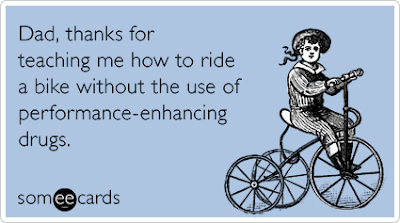Have you ever decided not to participate in a bike ride--or any other event--because of its name?
Or has such a name ever been so vile, repulsive and opposed to all of your values that you simply had to check out the event?
I've just come across such an event: The Dead Baby Downhill.
Now, to be fair, no babies are harmed or killed in the ride. From what I can see, there weren't very many babies anywhere near it.
The ride is sponsored by--you guessed it--the Dead Baby Club, which has been described as what a motorcycle club would be if its members rode bicycles.
One of the requirements for participation in the club and event seems to be tatoos. Another seems to be a quirky sense of humor.
The ride itself is really one event in the festival of--well, bikes, but also--shall we say--some creative costuming as well as food, drink and other things cyclists (and other people) enjoy.
One thing I would have loved to see is this

seven-human Monster Truck designed, engineered and fabricated by a boy-genius who calls himself Haulin' Colin.
A good time was had by all, I'm sure. And they will tell their children and grandchildren about it.
Or has such a name ever been so vile, repulsive and opposed to all of your values that you simply had to check out the event?
I've just come across such an event: The Dead Baby Downhill.
Now, to be fair, no babies are harmed or killed in the ride. From what I can see, there weren't very many babies anywhere near it.
The ride is sponsored by--you guessed it--the Dead Baby Club, which has been described as what a motorcycle club would be if its members rode bicycles.
One of the requirements for participation in the club and event seems to be tatoos. Another seems to be a quirky sense of humor.
The ride itself is really one event in the festival of--well, bikes, but also--shall we say--some creative costuming as well as food, drink and other things cyclists (and other people) enjoy.
One thing I would have loved to see is this
seven-human Monster Truck designed, engineered and fabricated by a boy-genius who calls himself Haulin' Colin.
A good time was had by all, I'm sure. And they will tell their children and grandchildren about it.









